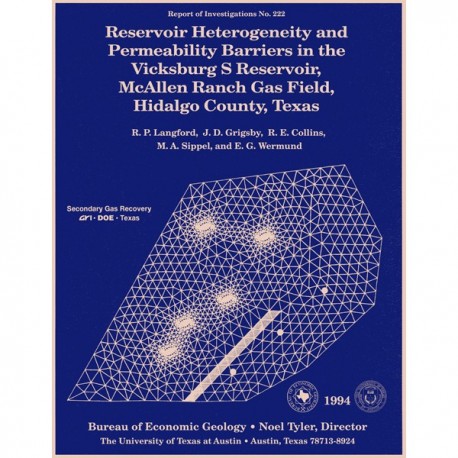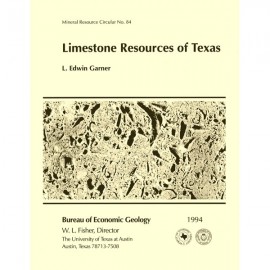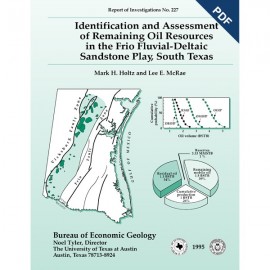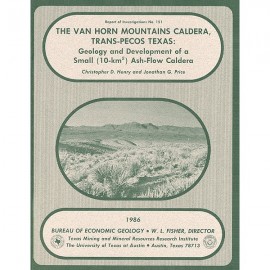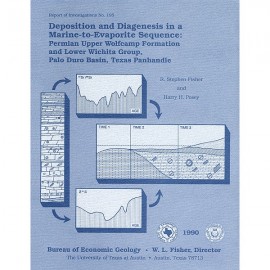Reports of Investigations
-
Books & Reports
- Reports of Investigations
- Guidebooks
- Udden Series
- Geological Circulars
- Down To Earth
- Atlases of Major Oil and Gas Reservoirs
- Texas Memorial Museum Publications
- Environmental Geologic Atlas of the Texas Coastal Zone
- Mineral Resource Circulars
- Other Reports
- Seminars and Workshops
- Handbooks
- Submerged Lands of Texas
- Symposia
- Annual Reports
- Open File Reports
-
Maps & Cross Sections
- Thematic Maps
- Miscellaneous Maps, Charts & Sections
- Geologic Atlas of Texas
- STATEMAP Project Maps
- Geologic Quadrangle Maps
- Cross Sections
- Highway Geology Map
- Energy and Mineral Resource Maps
- Shoreline Change and Other Posters
- Wilcox Group, East Texas, Geological / Hydrological Folios
- Bouguer Gravity Atlas of Texas
- River Basin Regional Studies
- Featured Maps
- Posters
- Teachers & the Public
-
Geological Society Publications
- Gulf Coast Association of Geological Societies
- Alabama Geological Society
- Austin Geological Society
- Corpus Christi Geological Society
- Houston Geological Society
- Lafayette Geological Society
- Mississippi Geological Society
- New Orleans Geological Society
- South Texas Geological Society
- GCS SEPM Publications
- Historic BEG & UT Series
Reservoir Heterogeneity and Permeability Barriers in the Vicksburg S Reservoir, McAllen Ranch Gas Field, Hidalgo County,
RI0222
For a downloadable, digital version: RI0222D.
RI0222. Reservoir Heterogeneity and Permeability Barriers in the Vicksburg S Reservoir, McAllen Ranch Gas Field, by R. P. Langford, J. D. Grigsby, R. E. Collins, M. A. Sippel, and E. G. Wermund. 64 p., 37 figs., 4 tables, 1994. Print.
To purchase this publication as a downloadable PDF, please order RI0222D.
About This Publication
This report documents research done on the mature and prolific McAllen Ranch gas field in South Texas, as part of the Secondary Gas Recovery (SGR) project funded by the Gas Research Institute, U.S. Department of Energy, and State of Texas.
ABSTRACT
A Secondary Gas Recovery project study in South Texas demonstrated that reservoir compartmentalization can result in reserve growth in a mature gas field. McAllen Ranch is an important field in that it typifies South Texas gas fields that produce from the deep, overpressured sandstone reservoirs of the Oligocene Vicksburg Formation. In this study, using the Vicksburg S reservoir in McAllen Ranch field as an example, we described heterogeneities that may compartmentalize lower Vicksburg gas reservoirs. A numerical model of part of the Vicksburg S reservoir demonstrates that pressure differences between adjacent wells result from low-permeability barriers to gas flow within the reservoir, not from the generally low permeability of the reservoir; therefore, pressure differences are partially the result of compartmentalization.
McAllen Ranch field produces from 33 lower Vicksburg reservoirs at depths that range from 9,000 to 14,000 ft (3,000 to 4,260 m). Our research concentrated on the Vicksburg S reservoir, which consists of six stacked progradational sandstones termed S1 through S6. This reservoir is the most productive in the field, having had a cumulative production of 162 Bcf by the end of 1988.
Faults, depositional heterogeneity, and diagenetic heterogeneity are all important agents of compartmentalization in the lower Vicksburg reservoirs. In the Vicksburg S reservoir, each type of heterogeneity may be important in different areas of McAllen Ranch field. In south McAllen Ranch field, the Vicksburg S reservoir is compartmentalized by faults. Distributary-channel-fill sandstones are the most likely to contain untapped reserves because they are laterally discontinuous. In the north, or B area, the S reservoir contains thick, laterally continuous delta-front sandstones and offers the poorest potential for depositional compartments. Diffuse, diagenetically created zones of low permeability are probably the most important restrictions to gas flow in the B area.
Depositional heterogeneity that may inhibit the flow of natural gas is present in McAllen Ranch reservoirs on four different scales: (1) The largest scale of heterogeneity is that of individual small and strike-elongate deltas (-3.5 x 7 mi [-5.5 x 11 km]). (2) Within each delta are lobes 1,000 to 4,000 ft (300 to 1,200 m) in width. (3) Individual distributary-channel bodies are 3,000 to 9,000 ft (1,000 to 3,000 m) in width. (4) Within individual sandstone bodies, higher permeability zones that are 1 to 2 ft (0.3 to 0.6 m) in thickness are in the coarsest distributary-channel and delta-front sandstones. Three different diagenetic facies are present in McAllen Ranch cores: quartz cemented, calcite cemented, and chlorite cemented. Intercalation of the three diagenetic facies results in heterogeneous porosity and permeability distributions. Diagenetically controlled low-permeability zones are probably the most important factors in creating permeability barriers in north McAllen Ranch field, where sandstone bodies are laterally continuous.
Original reservoir pressures were measured in wells drilled within the developed parts of the field long after initial production. The newly completed wells are adjacent to older wells that have shut-in pressures as much as 8,000 psi lower, suggesting that heterogeneities within the reservoirs may create barriers to gas flow between the newer and older wells. Analysis of production and pressure data indicates that neither water drive nor compaction is an important mechanism in the Vicksburg S reservoir. We created a finite-element model of the S4 sandstone, demonstrating that barriers to gas flow must exist between wells and that high pressures and gas production in the new wells result from compartmentalization of the reservoir rather than from low permeability.
The presence of permeability barriers does not necessarily indicate reservoir compartmentalization that results in increased reserves of natural gas. Reserve increases from lower Vicksburg reservoirs may form a significant resource when the original completion spacing is greater than the compartment sizes. Assessment of reservoir compartmentalization is difficult in low-permeability reservoirs. Nevertheless, in this part of McAllen Ranch field, the field operator, guided in part by a 3-D seismic survey, has indicated a reserve growth potential of more than 100 Bcf. This reserve growth is due to reinterpretation of reservoir distributions in relation to structure and not to reservoir compartmentalization within a single reservoir. However, reservoir compartmentalization has resulted in a minimum of 1.12 Bcf of reserve growth from two S2 recompletions out of six attempts in the S2 and S4 sandstones.
Keywords: gas reservoir, Gulf Coast, reserve growth, reservoir heterogeneity, South Texas, Vicksburg Formation
CONTENTS
Abstract
Introduction
Objectives
Procedures
Location, Stratigraphy, and Structure
Field History
Reservoir and Production Characteristics ,
Vicksburg S Reservoir Stratigraphy ,
Depositional Environments of the Lower Vicksburg Formation
Lower Vicksburg Facies
Prodelta and Shelf Mudstones and Siltstones
Distal Delta-Front Sandstones and Mudstones
Proximal Delta-Front Sandstones
Distributary-Channel Sandstones
Depositional Environments of the Lower Vicksburg Deltas
Vicksburg Deltaic Depositional Architecture
Reservoir Heterogeneity within the Vicksburg S Reservoir
Reservoir Segmentation Caused by Faults
Depositional Heterogeneities
Stratigraphic Heterogeneity
Stratigraphic Heterogeneity within Individual Deltaic Intervals
Lateral Arrangement of Sandstones
Proximal to Distal Deltaic (Large-Scale) Heterogeneity
Delta Lobes
Laterally Discontinuous Sandstones
Diagenetic Heterogeneity
Introduction
Diagenetic Facies
Quartz-Overgrowth-Cemented Facies
Calcite-Cemented Facies
Chlorite-Cemented Facies
Types of Diagenetic Heterogeneity
Entire Sandstones
Reservoirwide Porosity Variation
Low-Permeability Intervals
Thick Diagenetic Bands
Thin Diagenetic Bands
Effects of Diagenetic Heterogeneity
Summary of Reservoir Heterogeneity
Permeability Barriers
Research Questions
Experiment Site
Complicating Factors
Production from Uncompartmentalized Reservoirs
Low-Permeability Reservoirs
Multilayer Completions
Compaction
Water Drive
Factors Influencing Uncompartmentalized Production
Summary
Compartmentalized Reservoirs
Reservoir Models
Model Parameters
Results of Model Studies
Reserve Growth
Extrapolation to Other Fields in the Vicksburg Gas Play of South Texas
Conclusions
Acknowledgments
References
Appendix: Calculation of Effective Drainage Area and Individual Well Statistics
Figures
1. Map of the Texas Gulf Coastal Plain showing McAllen Ranch field in South Texas and major Oligocene growth faults
2. Map of McAllen Ranch field showing distribution of wells and cores available in this study
3. Tertiary stratigraphy in the McAllen Ranch field area
4. Type log illustrating stratigraphy of most Vicksburg reservoirs at McAllen Ranch field
5. Northwest-southeast dip-oriented seismic line showing selected gas reservoirs in McAllen Ranch field and underlying contact with Eocene shales
6. Map showing distribution of producing reservoirs in McAllen Ranch field
7. Structure-contour map, top of the Vicksburg S reservoir, lower Vicksburg Formation
8. Annual production from McAllen Ranch field illustrating development of successive groups of reservoirs
9. Northwest-southeast cross section A-A' of the Vicksburg S reservoir in the B area in north McAllen Ranch field, showing rollover into the growth fault
10. Photograph of sedimentary structures evident in cores of prodelta and shelf mudstone and siltstone facies: thin, upward-fining sequences containing clay rip-up clasts, climbing ripples, load cast, and clay dike
11. Photographs of sedimentary structures making up individual upward-fining sequences of the delta-front facies
12. Distribution of depositional and diagenetic facies within Shell A. A. McAllen No. B-18 (core 4)
13. Distribution of depositional features and petrophysical properties within a typical lower Vicksburg distributary-channel sandstone, Shell Woods Christian No. 6 well
14. Log facies map of sandstones in the S1 interval
15. Cross-sectional models of depositional environment and geometries of strata within Vicksburg deltas
16. Northwest-southeast cross section B-B' illustrating arrangement of facies in S5 and S6 deltaic intervals
17. Monthly production history of Shell A. A. McAllen No. B-12 well illustrating production increases resulting from recompletion
18. Number of sandstones found in wells in the S1 interval
19. Number of sandstones found in wells in the S4 interval
20. Well logs projected into southwest-northeast cross section C-C' in B area of McAllen Ranch field, illustrating delta lobes evident in the S4 sandstone interval
21. Map of net sandstone thickness within the S4 interval
22. Map of the two uppermost sandstones in the S, interval in southwest corner of the S reservoir subcrop, illustrating extent of channels, distribution of completions, and opportunities for additional completions
23. Plot of distribution of porosities and permeabilities of different diagenetic facies in the Shell A. A. McAllen No. B-18 (core 4)
24. Distribution of diagenetic facies within the Shell A. A. McAllen No. B-18 (core 1)
25. Completion pressures in the Vicksburg S reservoir illustrating increasing spread in completion pressures over time
26. Pressure-distance graph illustrating how high pressure in an offset well can result from either low permeability or an intervening permeability barrier to gas flow in a reservoir of higher permeability
27. Plot of permeability and shut-in pressure in the Shell A. A. McAllen No. 2 well, illustrating decline in permeability with decreasing pressure, indicative of creep compaction
28. Map of permeability-thickness values used in the S4 sandstone simulation, locations of producing wells in the B area, and hypothetical low-permeability barrier to gas flow
29. Map of grid of finite-element model used for estimating permeabilities within the S4 interval
30. Simulated pressure history at the location of Shell A. A. McAllen No. B-15 well showing the match with pressure measured on completion of well
31. Simulated pressure history at the location of Shell A. A. McAllen No. B-18 completion showing that pressures cannot be matched to the near-virgin wireline pressure without adding a significant barrier to gas flow
32. Map of wells in the B area, Vicksburg S reservoir, showing calculated effective drainage radii of S2 completions
33. Map of wells in the B area showing calculated effective drainage radii of S4 completions.
34. Date of reservoir discovery plotted against cumulative production as of December 1990 in reservoirs of the VK-1 play
35. Depth plotted against cumulative production as of December 1990 in reservoirs of the VK-1 play
36. Average well spacings of selected VK-1 fields
Tables
1. Sources of cores and supporting petrophysical data used in this report
2. Sources of data used in petrophysical analyses of the Vicksburg S reservoir in the B area
3. Geometries and petrophysical properties of the depositional facies
4. Comparison between modeled permeabilities and permeabilities measured in well tests
5. Effective drainage area of Vicksburg S reservoir wells in the B area of McAllen Ranch field
Citation
Langford, R. P., Grigsby, J. D., Collins, R. E., Sippel, M. A., and Wermund, E. G., 1994, Reservoir Heterogeneity and Permeability Barriers in the Vicksburg S Reservoir, McAllen Ranch Gas Field: The University of Texas at Austin, Bureau of Economic Geology, Report of Investigations No. 222, 64 p.
